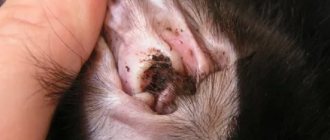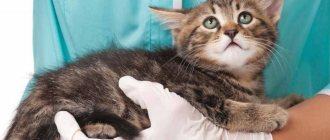General information about the symptoms and treatment of the most common ear diseases in cats. How to recognize and prevent these diseases.
Ears are a cat's weak point. They have a complex anatomy, so they are often exposed to various diseases. Problems can affect both the visible parts of the ear (pinna, external auditory canal) and those that are inaccessible to the human eye (middle ear, inner ear).
Ear diseases in cats can be parasitic, fungal, infectious, inflammatory and traumatic.
All these reasons are most often caused by insufficient care of the animal and reduced immunity. If the owner is attentive to his pet, shows responsibility, and strengthens the cat’s immunity, the risk of ear pathologies can be minimized.
In this article you will learn why a cat may have ear pain, causes, symptoms and treatment methods. We will also talk about how to prevent these diseases or reduce the likelihood of their occurrence.
General symptoms of ear diseases in cats
The main signs of ear diseases in cats are easy for owners to identify; for this, it is necessary to regularly examine the animal.
Even if you have the necessary medications and remedies in your home medicine cabinet, you should not immediately begin treatment; it is better to entrust the diagnosis to specialists who focus on the following symptoms:- painful sensations in animals when palpating the ears;
- scratching the ear area and the ears themselves until bloody wounds appear;
- the animal often shakes its head and touches its ears with its paws;
- the pet has an unpleasant odor coming from the ears;
- the swelling of the outer part of the auricle is visually determined;
- During hygiene procedures, discharge from the ears is observed.
Read here Pyometra in a cat - causes of the disease, symptoms, treatment and possible complications (120 photos)
To make a timely diagnosis and develop an effective treatment plan, hygiene procedures should be carried out regularly.
A weekly examination of your pet will help you immediately identify a problem with the ears and contact an experienced veterinarian who will conduct an examination and the necessary tests.
What pathologies can affect a cat's ears?
Basically, the ears are affected by various parasites and mites. No less rarely, inflammatory infectious processes in the ears are diagnosed in animals. Hearing problems also arise as a result of injuries. The cat may suffer:
- otodectosis - a dangerous and serious disease that requires immediate treatment;
- otitis media and other pathologies of the outer and inner ear;
- eczema;
- dermatitis;
- hematomas, abscesses;
- tumors of different nature and degree of malignancy;
- necrosis.
Otodectosis
This pathology is caused by mites that parasitize the auricle and ear canal. A pet becomes infected with ticks through contact with a sick relative. Moreover, it is impossible to see a tick with the naked eye. Accumulations of parasite waste products are found in the ears.
Main symptoms of the disease:
- severe itching of the skin, while a large amount of deposits accumulates inside the ear;
- severe redness and scratching of the ear;
- anxiety due to severe itching and pain;
- the appearance of brownish scabs in the ear;
- dissemination of a strong foul odor;
- constant tilting of the head to the side affected by the infection.
If therapy is refused, the course of the disease becomes more complicated and is accompanied by:
- inflammation of the middle and inner parts of the ear, threatening deafness;
- the appearance of hematomas;
- perforation of the eardrum;
- inflammation of the membranes of the brain.
To get rid of the pathology, an effective veterinary drug BlochNet max is prescribed. It must be dripped into the ear, 4-6 drops, several times with a break of 5-7 days. The medicine should be injected into both ears, even if the mite has affected only one.
In the absence of this drug, the veterinarian prescribes antiparasitic and antibacterial agents. They treat the ears until the symptoms of the pathology are completely relieved. Self-medication of otodectosis is very dangerous.
Otitis
This is an inflammation of any part of the ear. In cats, the disease is a typical consequence of otodectosis. The most dangerous is otitis media, which affects the inner ear. Symptoms of the disease:
- redness of the inside of the ear;
- the appearance of a strong unpleasant odor;
- the appearance of purulent or even bloody discharge;
- a sharp decrease in hearing (moreover, some cats may experience periodic hearing loss);
- due to ear pain, the cat cannot chew solid food and especially dry food (preferring soft food instead);
- There is copious discharge of mucus or pus from the eyes;
- inflammation of the parotid lymph nodes is observed.
The most dangerous complication of otitis media in cats is meningitis. Without urgent treatment, it ends in death. Treatment depends on the form of otitis and includes the following measures:
- To get rid of purulent otitis media, antibiotics, hydrogen peroxide, and chlorhexidine are used. It is necessary to rinse the auricle with these medications.
- For chronic otitis media, veterinary antibiotics and compresses based on Dexamethasone are used.
- Wetzym veterinary drops are used to treat otitis externa.
- In case of fungal infection, a solution of phosphoric acid is prescribed, which needs to be used to treat the ears.
- With allergic otitis media, you first need to establish the cause of the disease, and only then prescribe certain pills.
Dermatitis and eczema
Dermatitis can occur due to skin damage from fleas and ticks. Because of this, the pet is constantly itching behind the ear. Numerous wounds and ulcerations appear on the auricle itself, which bother the animal with very severe itching. Scratching causes the affected area to increase.
Dermatitis can also be caused by a severe allergy to food or some environmental factors. With eczema, the skin of the ear swells and swells. Foul-smelling exudate accumulates inside the cavity. The pet constantly tilts its head and tries to get rid of the obsessive itch.
Exudate and other deposits are removed with hydrogen peroxide or a solution of baking soda. Wet areas should be lubricated with astringent preparations:
- lapis;
- Pyoctanin;
- picric acid;
- boric acid;
- zinc ointment.
For very severe itching, Cardiazol is prescribed.
Hematomas and abscesses
These diseases are associated with trauma to the animal. Hematoma is a consequence of mechanical damage to the auricle. Hematoma can be found especially often in cats in the spring, when they fight for a female. A cat may have not only bruises, but also scratches and other types of injuries. The ear can also be injured after a fall from a great height.
A hematoma appears as a result of a closed injury to the auricle. The affected area hurts very much. The pet is restless, presses his ear and does not allow him to be touched. The stages of development of a bruise are no different from those that occur in humans. The inflammatory process can develop after blood leaves the blood vessels. Due to untimely provision of assistance, suppuration and infection occur.
For hematomas, the cat is prescribed cold. An open wound should be treated with disinfectant solutions. If there is bleeding, it is important to apply a pressure bandage to the ear to reduce the rate of blood flow. An abscess always appears when there is an open wound or intense infection of the affected area of the body. Dust, sand, and earth almost always fall on an open wound.
If the affected area is large and the inflammatory process develops rapidly, surgical treatment is indicated. The doctor cleans the wound of fibrin and blood clots. After cleansing the wound, a sterile dressing is applied. This event is carried out using local anesthesia. It is necessary to prevent the animal from scratching its ear.
For hematomas, ointments are used: Levomekol or Lecomycetin. In case of severe suppuration, Vishnevsky's liniment and ichthyol ointment are used. Additionally, antibiotic therapy is used.
Ear tumors
They are rare in animals. But precisely because pet owners know little about the peculiarities of the development of tumors, they turn to the doctor only when the tumor is in an advanced stage and the choice of effective treatment methods is small.
Ear tumors in cats are divided into malignant and benign. The main symptoms of malignant tumors in the ear:
- a pronounced putrid odor emanating from the ear;
- the appearance of areas of baldness;
- the appearance of wounds in the auricle, from which a large amount of discharge of a different nature comes out;
- ear deformation.
Malignant pathologies of the auricle often occur in cats over the age of 10 years. Sometimes those animals that spend a lot of time in the open sun develop cancerous lesions of the ears. Carcinomas are prone to metastasis, sometimes this process develops rapidly.
Characteristic symptoms of benign ear tumors:
- severe itching of the ear, causing the animal to constantly scratch the ear and often tilt its head;
- slight discharge from the ear is observed;
- the ear increases in volume, and significant swelling forms inside the shell.
Benign neoplasms most often appear in animals over 7 years of age. Most often the ear can be affected by osteoma, ceruminoma and atheroma. Benign formations lead to an uncomfortable state of the animal.
If the tumor is a polyp, it is removed surgically. The same treatment is prescribed for all other types of neoplasms. Subsequently, it is recommended to take a course of antibiotics. To reduce pain, analgesics and NSAIDs are used in veterinary medicine.
Treatment for ear cancer may require removal of the ear canal or pinna. In the presence of metastases, chemotherapy is used. The prognosis for the course of a benign neoplasm is favorable. A cancerous tumor detected and removed in time can be treated, the outcome of which is favorable. In the presence of metastases, the prognosis worsens.
Necrosis
This is the name for progressive tissue death that develops as a result of hematoma or infection. As a result of tissue death, the ear turns black. It is impossible to cure such a disease. Surgeons decide whether to remove the affected part. If this is not done, the animal may develop gangrene and sepsis.
Ear diseases and ear canal diseases
It is quite difficult to independently determine what disease cats have near the ear; even experienced cat owners cannot do it.
Scratching and injuries can occur for various reasons, but they are often associated with diseases of the ears, which come in several types and require mandatory treatment.
What does a healthy cat ear look like?
The appearance of a healthy ear is a soft pink color of the skin inside the auricle, a slightly shiny but not wet surface, perhaps a small accumulation of light or dark brown wax without a strong odor. A more in-depth study can only be carried out by a veterinarian using special tools.
Injuries and wounds
A street fight for territory, a bite or independent, careless scratching can cause suppuration and inflammation.
You can treat the damaged areas yourself and seek help from a veterinarian who will carry out antibacterial treatment of the damaged area.
Hematomas
Hematomas appear as a result of an impact due to the accumulation of dried blood under the skin of the animal, which appears after the rupture of blood vessels.
Swelling and swelling, darkening of the skin requires mandatory examination and further treatment; surgical intervention is often prescribed, which involves opening the hematoma.
Scabies mite
Outdoor cats are often exposed to ectoparasites, such as the scabies mite, which causes itching in the ear canal.
The presence of a lesion can be determined by undergoing laboratory tests and examining scrapings taken from the pet’s ears, after which special drug therapy is prescribed.
Solar dermatitis
The tips of an animal's ears can be damaged under the influence of ultraviolet and solar radiation, which is typical for light-colored animals.
Seizures in cats - main causes, symptoms, first aid, treatment and choice of drugs (110 photos)Polycystic kidney disease in cats - causes, diagnosis and symptoms of the disease. Treatment options and prevention of kidney disease (95 photos)
Tartar in cats - signs of the disease and methods of fully treating tartar (125 photos + video)
Timely treatment of cat ear disease caused by solar radiation will prevent the development of cancer; most often, removal of the tips of the ears is prescribed.
Parasitic otitis media
Otitis in cats develops against the background of inflammatory processes and damage to the ear canal by endoparasitic mites.
Parasites live in or around the ear canal; their waste products cause a severe allergic reaction in the pet, which leads to the development of an inflammatory process.
How to understand that a cat is bothered by a sore ear, symptoms
The following symptoms indicate inflammatory lesions:
- loss of appetite;
- the auricle turns red, swells, and the local temperature rises;
- the pet shakes its head, as if trying to shake out a foreign object from the organ of hearing;
- you can hear the fluid gurgling in the affected organ;
- the cat scratches its ear with its paw;
- the animal meows pitifully;
- tilts his head towards the disturbing organ of hearing;
- upon examination, crusts are found, as well as pus or discharge resembling coffee grounds;
- drooping lip, eyelid or ear;
- the pet avoids stroking the head;
- the ear smells unpleasant.
Be sure to read:
A cat bite has a swollen hand: what to do, first aid, why it is dangerous, how to treat it, what not to do
Otitis is characterized by exhausting pain, however, if the disease is detected at the initial stage, then the cat can be helped.
Tumors and neoplasms
Tumors and polyps in cats develop on the middle and inner ear, on the skin lining the ear canal.
The diseases are typical for older animals; malignant neoplasms require mandatory surgical intervention or the selection of special therapy.
Arthropod parasites
Spot-on drops against fleas.
helminths and mites Crusts are formed as a result of the activity of subcutaneous mites Otodectes and Notoedrus. Arthropod parasites constantly live in the cat’s body, but do not cause any significant harm to it as long as the immune system restrains their reproduction.
Otodectes parasitize from the inner surface of the auricle. They dig holes under the skin and lay eggs. The damaged surface itches, an ichor forms, and when it dries, crusts form.
If the inner surface of the sink is dry, soften the crusts and apply Amidel-gel, Amitrazine, Amit, Ivermek-gel or similar acaricidal agents. Most often, treatment consists of two applications at a five-day interval.
In advanced cases, otitis media develops. A mass similar in consistency to coffee grounds spills out of the ear canal. In such cases, ear drops Surolan, Aurikan, Otibiovin are used for treatment.
Unlike Otodectes, Notoedrus mites parasitize on the outside of the shell. Arthropods love to travel. They rise through tunnels to the surface of the skin, and upon contact they can move on to other individuals, including people who stroked the kitty. Mites can live for several weeks on uncomfortable human skin and cause redness and itching.
However, the parasite does not reach sexual maturity and the pathological condition ends with a quick recovery without any treatment.
With Notoedrosis, in addition to the ears, the muzzle is affected
Notoedrus first causes baldness and crusting on the outer surface of the shell. Then they spread to the face and torso. Cats sleep curled up in a ball, so traveling parasites quickly spread throughout the body. Treatment is carried out with the same drugs as for otodectosis.
Be sure to read:
Discharge in a cat: what does it mean, causes, norm and pathology, what to do, how to treat
However, instead of two treatments, five may be required. Prevention consists of adequate feeding, as well as regular use of Spot-on drops against fleas, helminths and subcutaneous ticks.
Foreign bodies
Owners of animals who suffer from pain that appears as a reaction to foreign bodies located in the ear canal turn to specialists.
These can be specks of dust and specks, grass seeds or organic plant remains; experienced veterinarians know how to treat ear diseases in cats and carry out the necessary manipulations to alleviate the animal’s condition.
Skin diseases
If crusts suddenly appear on a cat’s ears, the animal behaves lethargically, refuses to eat and sleeps a lot - the reason should be sought in a decrease in immunity. This may be accompanied by the formation of crusts on the face and thinning of the coat.
Ears are a kind of marker of the general condition of a cat’s body. In the event of an allergic reaction, this delicate part of the body is the first to react. Allergies can be caused by:
- changing your diet;
- contact with household chemicals;
- reaction to drugs;
- climate change.
Small kittens and older animals react very sharply to changes in diet. Feeding a new food, switching to natural food - all this can cause food allergies.
Cats are curious animals, which is why they often come into contact with household chemicals and other irritating substances. Contact of washing powder and other household products on an animal's skin can cause an allergic skin reaction.
Often the appearance of crusts on the ears and face of a pet is due to a reaction to drugs. First of all, they release anti-flea products that drip onto the withers. They can be toxic, which is manifested by a specific allergic reaction in the form of crusts and bald patches on the ears.
A fairly rare cause of the appearance of crusts on the tips of the ears of a furry pet is solar eczema. The disease is a consequence of the skin's reaction to ultraviolet radiation. Smooth-haired animals and breeds without hair are more susceptible to this dermatological reaction. An important factor in the development of photodermatitis is the color of the ears and fur - this disorder is usually characteristic of white cats with pink skin.
You might be interested in: The cat has a broken fang: how to help the animal?
Photos of ear diseases in cats
Ringworm in cats - main signs, symptoms, prevention and treatment of ringworm in cats (105 photos)Pancreatitis in cats: first symptoms, nutritional nuances and treatment options (125 photos and videos)
Subcutaneous mites in cats - first symptoms, treatment options and real photos of examples of parasite damage (110 photos + video)
Help the site, share with friends












